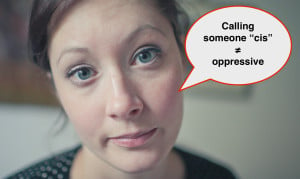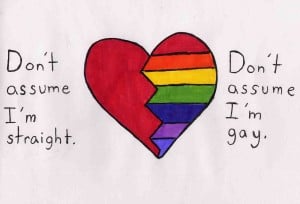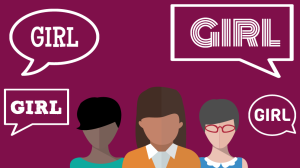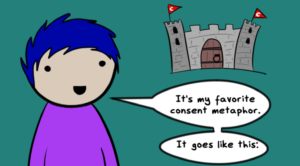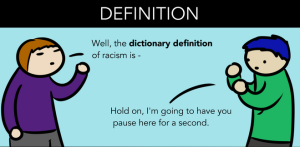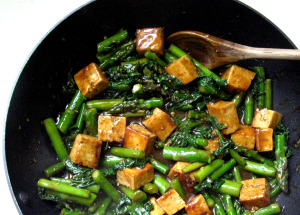
Stir fry with tofu and asparagus in a black pan. Source: Live. Love. Learn. Eat.
I began cutting meat out of my diet before I started marching for women’s rights, but that doesn’t mean they aren’t connected. However, connecting the dots between feminism and vegetarianism or veganism is often easier than actually eating less meat.
I became a vegetarian, quite simply, because eating meat felt wrong.
After I read literature and watched videos about how animals were treated in captivity by the meat industry and the disgusting and inhumane practices that went into producing my cold cuts, pork chops, and chicken cutlets, America’s culture of meat began to look very different to me.
Later on, I came across feminist writing that related speciesism to sexism, and I realized that normalizing violence and hostility toward livestock and any animal made it easier to normalize violence and hostility toward the members of our society people deem less “worthy” of humane treatment (like, say, women, people of color, and trans and queer folks).
As I embarked on a vegetarian diet, I also realized that what I knew about meat and nutrition had been skewed by my culture and the meat industry.
I learned that livestock emit lots of methane gas, making them a leading cause of climate change, and I started seeing how meat production, shipment, and consumption was adding to everyone’s carbon footprint.
I found out that a world without meat could be a world without hunger.
Contrary to everything I’d learned, it turned out that eating a vegetarian diet could actually extend my life – and that red meat is actually not that healthy at all.
After all of that, I knew I couldn’t turn back.
And even though the “icky” factor of meat has somewhat faded for me over the years, I’ve never gone back to eating it. Giving up meat was a defining decision in my life, and I’ve never regretted it.
My body feels great, my meals are filled with variety, and I know every time I sit down to eat that I’m doing so in a way that aligns with my values.
It’s been a long journey, though, and along the way, I encountered obstacles related to my family, my health, and my wallet.
In a society where meat is mainstream, I had to make a choice to defy social norms and wade through misinformation in order to figure out a diet that worked for me and aligned with my values.
Figuring out how to go without meat was complex, but it was far from impossible.
The meat industry is pretty awful, but it’s also a way of life. Meat is central to so many cultures and societies that considering going without it can freak us out.
If there’s something about giving up meat that gives you pause, there’s probably a way to make it work despite the obstacles.
1. My Family Isn’t Into It
Culture is important, and in some families, food is sacred ground.
When I went vegetarian, my Italian grandmother immediately thought of her sauce. When immigrant families put meat on the table, they can feel as if they’re finally living that American Dream.
And when your partner, friends, or family give you a hard time about wanting to eat less meat, it can put a damper on your plans.
But guess what. Going meat-free doesn’t have to mean making a choice between who you love and who you want to be.
If your family, friends, or loved ones are giving you a hard time about eating less meat, approach the situation the same way you would approach any conflict or disagreement with them.
Listen to what they have to say, and then figure out how to meet them in a middle ground.
If your family shows love through food, help them figure out new recipes that you can enjoy with them.
If they can’t help but feel judged by your decision to abandon meat, ease up on that conversation about the politics of meat on Thanksgiving. Cook new recipes for your relatives to try that don’t use meat or animal-based ingredients. Show your partner how to make meat-free versions of the dishes you’ve shared together for years.
If someone you love is hesitant to embrace your new diet, hear them out and help them adjust.
When I became a vegetarian, my family wasn’t into it. And ultimately, that was okay. I compromised and ate sauce that had been prepared with meat in it, even though it meant picking out the pieces, so that my grandmother knew I still loved her cooking.
Since my mom didn’t want to cook entirely different meals for me every night, I was sure to know in advance what I needed for the week so that I could find it, buy it, prepare it, and cook it for myself.
Be willing to take the journey alone, but don’t let your newfound enthusiasm for a brand new diet create distance.
Give it time, and you and the people you’re close to will figure out a new rhythm that accommodates your values. And who knows? You could end up teaching them a thing or two (and probably a killer tofurkey recipe).
2. I’m Worried About My Health
I learned a lot about nutrition in a setting where meat was seen as central to nourishing and taking care of your body. But that’s not the only way. Meat can be a part of a healthy diet, but eating meat isn’t the only way to be healthy.
Meat does provide people with valuable nutrients like iron, and it can be a powerful source of protein — but it isn’t the only way to get those nutrients and power your body.
Eating less meat or cutting out meat and animal products altogether can be a healthy decision, and can even be healthier for you than eating meat, especially at the rate so many Americans do each day.
If you want to eat less meat, make sure you know how to do it without compromising your health. (A quick pro tip? Start taking a daily multivitamin, and start taking it now.)
There are plenty of books, magazines, and websites devoted to meat-free diets that can walk you through the building blocks of eating less meat, and once you’ve learned how to make up for the protein, vitamins, and minerals you’re giving up, you’ll be good to go.
A vegetarian or vegan diet, just like a meat-based or meat-inclusive diet, can be healthy, nourishing, and good for you – but you have to do the work to make it work.
If you have a medical condition or a super active lifestyle and you’re worried about how cutting back on meat might impact you, talk to a doctor. Eating less meat may not be presented to us as a cultural norm, but it’s not nutritionally impossible in a majority of circumstances.
And even if it isn’t on the table for you to cut out meat or animal products entirely, working with a professional or doing some research can help you cut back on your meat consumption and eat meat more ethically.
3. I Don’t Like Vegetables
If you don’t like vegetables, chances are that the words “vegetarian” and “vegan” make you wary. But that doesn’t need to be the case!
Eating less meat or giving it up altogether doesn’t mean you’re going to spend the rest of your life snacking on celery sticks or boiling Brussels sprouts.
In fact, eating less meat can open your eyes to how many amazing meals and snacks are out there that don’t harm animals – and not all of them just a pile of actual vegetables.
Think about the things you probably already eat that don’t involve meat or, in some cases, animal products.
What’d you come up with? I thought of grilled cheese, peanut butter and jelly, baked potatoes, and good ol’ macaroni and cheese.
Some meals that might typically include meat are also just as great without, like pasta with sauce, tacos and burritos, egg sandwiches, and pizza.
If you really dig the taste of meat, you can also rest easy knowing that there’s probably a substitute for it out in the big, wide world of meatless meats. Chances are, a vegetarian or vegan version of your favorite meat dish exists already.
Whether you’re going to miss bacon, hamburgers, hot dogs, sloppy joe sandwiches, Italian sausage, or chicken tenders, there’s an imitation meat on the market that will make it all better.
Most grocery stores and even some restaurants carry these fake meats, and it makes being a vegetarian or vegan — and finding a solid source of protein — even easier. (These options are also often heart-healthier and may even be made with vegetables, so it might end up being a win-win.)
But that’s not all! Fake meat isn’t even the only way to add something to your plate once you give up the real thing. Seitan, tofu, tempeh, and even quinoa can be valuable sources of nutrients and become new staples for you in a meat-free diet.
4. I’m Gonna Miss Meat
If fake meat just isn’t gonna do it for you, or if the thought of going all-out and giving up your favorite meat dishes is too much to handle, the solution is simple: Don’t give up eating meat entirely.
Eating less meat isn’t an “all or nothing” game. You can still alter your meat consumption in a way that aligns with your values without scrapping your favorite cuts altogether.
Meatless diets, like most things, exist on a spectrum, and not all of them involve giving up all meats.
A pescatarian diet cuts out all meat, but leaves seafood on the table; pollo vegetarians (or semi-vegetarians) eat chicken, turkey, and fish; and flexitarians eat small amounts of meat to their liking while mostly avoiding it altogether.
If your goal is to reduce your meat consumption without giving up any single meat entirely, setting boundaries can also help.
You could commit to eating meat only when you eat at restaurants, or you could conversely commit to only eating meat you’ve prepared yourself. You could stop eating meat for lunch, or you could try not eating it for dinner.
You can even make a dent in the fights against climate change and animal cruelty without giving up meat at all!
Committing yourself to buying meat from local farmers where workers and animals alike are treated ethically and with compassion will reduce your carbon footprint and the weight on your heartstrings.
Ultimately, your diet should be about making you happy, not struggling to resist the things you love.
Making room for your grandma’s legendary meatballs or getting your favorite Taylor ham sandwich at the deli back home doesn’t make you a bad person, and taking even one step toward reducing your meat consumption is a big step for the environment and animal rights.
5. I Can’t Afford It
When you give up meat, your diet changes.
Instead of eating chicken or beef with every meal, you have to find something else to fill you up and keep you healthy. That means an entire restructuring of how you’re shopping for food and what you’re making, and that’s a big change.
I’m aware that for folks without a lot of money, the idea of eating lots of produce can be daunting, and the expectation that they do it can be implausible and unfair. But altering your diet doesn’t have to be more expensive.
Buying in bulk can also be a great way to keep costs down while you’re changing your diet, and since lots of vegetarian meals are made with nonperishable or freezer-friendly ingredients, you’re bound to be in luck.
Buying local keeps your environmental impact down and can also be a great way to spot the cheapest produce and the most ethical vegetables.
Growing your own produce can also be a powerful option for folks who find themselves on a limited budget.
Once you make the investment in the proper materials and supplies, you could find yourself with an abundance of berries, herbs, vegetables, and fruits.
Gardening takes work and time, but it ends up being very cost-efficient and is a foolproof way to eat meals without relying on corporations, making a huge carbon footprint, or getting totally ripped off in the produce section.
No matter how you shop for or grow your new meals, you’re likely to find that staples for vegetarians come very cheap.
Beans, for instance, are an excellent source of protein and are super-filling. (Buying them in the bag and boiling them is even more affordable, though it involves a longer time commitment when you’re cooking.)
Replacing rice or pasta with quinoa may be more expensive, but it will keep you more nourished in the long run and last longer.
Kale is fortified with nutrients spinach doesn’t have, and it’s often around the same price or cheaper. If you like vegetables, eating them raw will give you good fodder for snacks and a very happy body.
***
I’ve been a vegetarian for twelve years – over half of my life – and I never looked back. But my way doesn’t have to be your way, and my diet doesn’t need to be your diet.
Whether your feminism is meat-free or not or somewhere in-between, starting it won’t be easy, and neither will keeping it up.
If you’re a feminist who’s worried about your meat consumption, what matters is that you do what works for you to eat in a way that reflects your values, even if that means you never become a vegetarian or find yourself compromising with your grandmother after over ten years of rice and beans.
And what matters most is that you figure out how to make it happen.
Now, if you’ll excuse me, I’ve gotta go check on my stuffed peppers.
[do_widget id=”text-101″]
Carmen Rios is a Contributing Writer for Everyday Feminism. She splits her time disparately between feminist rabble-rousing, writing, public speaking, and flower-picking. A professional feminist by day and overemotional writer by night, Carmen is currently Communications Coordinator at the Feminist Majority Foundation and the Feminism and Community Editor at Autostraddle. You can follow her on Twitter @carmenriosss and Tumblr to learn more about her feelings. Read her articles here.
Search our 3000+ articles!
Read our articles about:
Our online racial justice training
Used by hundreds of universities, non-profits, and businesses.
Click to learn more
Most Read Articles
- « Previous
- 1
- …
- 30
- 31
- 32





